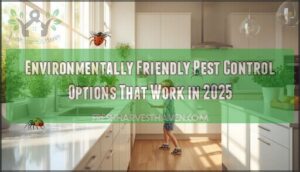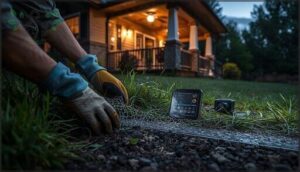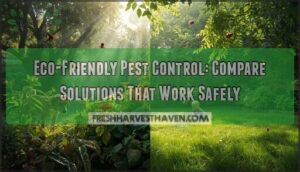This site is supported by our readers. We may earn a commission, at no cost to you, if you purchase through links.

The good news? Environmentally friendly pest control options have evolved far beyond ineffective folk remedies—they now deliver results that match or surpass chemical treatments while cutting toxic exposure by up to 80%. These methods work by disrupting pest behavior and habitats rather than poisoning everything in sight, which means you’re not just protecting your family’s health today, but building lasting defenses that keep pests away without the hidden costs of contamination.
Table Of Contents
Key Takeaways
- Switching to eco-friendly pest control cuts chemical exposure in your home by up to 80%, making your living spaces safer for both children and pets.
- Integrated Pest Management (IPM) and prevention-first strategies keep pests away for the long haul, reducing reliance on chemicals and boosting overall effectiveness.
- Natural solutions—like beneficial insects, physical barriers, and plant-based sprays—work as well as or better than traditional pesticides, supporting healthier indoor air and ecosystems.
- While you may pay a bit more upfront for green options, the long-term savings on health, maintenance, and repairs make them both cost-effective and sustainable.
Why Choose Environmentally Friendly Pest Control?
You’ve probably heard the buzz about going green with pest control, but does it really make a difference? The short answer is yes—and not just for the planet.
Let’s look at the real-world reasons why more homeowners are ditching the chemicals and reaching for eco-friendly alternatives that actually work.
Health and Safety Benefits
Your family’s well-being matters more than pests. Eco-friendly pest control slashes chemical exposure by up to 80%, protecting you from poisoning risks and respiratory health problems linked to traditional pesticides.
Eco-friendly pest control cuts chemical exposure by 80%, protecting your family from poisoning and respiratory harm
Nontoxic pest control methods dramatically reduce allergen reduction needs while keeping children and pets safer—homes report 60% fewer poisoning incidents. Safe pest control means cleaner indoor air, fewer asthma symptoms, and genuine peace of mind without compromising effectiveness.
Consider integrated pest management for a sustainable approach.
Environmental Impact Reduction
Protecting your family also means protecting the planet. Eco-friendly pest control cuts carbon emissions by 70% and slashes water contamination by up to 84% through vegetative barriers. You’re safeguarding pollinator health and reversing biodiversity loss while reducing chemical persistence in soil.
Environmental sustainability isn’t abstract—it’s about real impact. Integrated methods minimize the environmental impact of pesticides, proving you don’t need toxic solutions for effective control. This approach can reduce pesticide use by up to 50%.
Long-Term Effectiveness and Prevention
Beyond protecting the environment, you’re investing in IPM sustainability that actually lasts. Integrated Pest Management (IPM) maintains low pest populations over years, not weeks—apartments using IPM showed sustained results beyond three months.
Structural integrity improvements and biocontrol persistence reduce pest numbers by 73% while boosting yields by 25%. With monitoring technologies achieving 97% accuracy, you’re preventing infestations before they start, not just reacting to them.
Cost-Effectiveness Compared to Chemicals
You’ll spend 15-30% more upfront on eco-friendly pest control, but the long-term savings add up fast. Chemical pesticides rack up hidden costs—health expenses from exposure, environmental remediation averaging $10,000 to over $1 million per incident, and constant reapplications as pests develop resistance.
- Natural methods cost $8-60 per acre versus repeated chemical purchases at $50-200
- IPM reduces input costs while boosting farm profitability through decreased pesticide reliance
- The organic pesticides market is projected to reach $7.6 billion by 2032, proving economic viability
Core Principles of Eco-Friendly Pest Management
Effective eco-friendly pest control isn’t just about swapping chemical sprays for natural ones—it’s built on a foundation of smart, preventive strategies that work with nature instead of against it. These core principles guide every decision you’ll make, from identifying the root cause of an infestation to choosing the least toxic solution that actually works.
Let’s walk through the four essential approaches that make green pest management both sustainable and successful.
Integrated Pest Management (IPM) Approach
Think of Integrated Pest Management (IPM) as your strategic roadmap, not just a quick fix. This science-based decision-making process combines monitoring, identification, economic thresholds, and targeted control methods to manage pests effectively while protecting your family and environment.
Here’s how IPM stages and benefits compare:
| IPM Component | Key Outcome |
|---|---|
| Monitoring & Identification | Reduces pesticide use by up to 95% |
| Economic Thresholds | Cuts applications by 44% |
| Biological Controls | 80%+ success rates |
| Cost Savings | $191 profit increase per acre |
| Health Benefits | 35-40% fewer pesticide-related risks |
You’ll find IPM strategies deliver long-term pest management by addressing root causes, not symptoms. While barriers like complexity and upfront costs exist, the economics speak clearly: farms adopting IPM principles see yield increases around 40% and substantial reductions in chemical dependence, making this approach both sustainable and financially smart for your home or operation.
Prevention-First Strategies
When you stop pests before they settle in, you’re already winning the battle. Prevention-first strategies—sealing entryways, habitat modification, clutter management, and strict sanitation practices—reduce pest populations by up to 60% without chemicals.
Integrated pest management starts here: exclusion methods like door sweeps and vent covers, combined with continuous monitoring, catch problems early and slash long-term costs while keeping your home safe.
Education and Client Involvement
Understanding IPM transforms how you tackle pests at home. Nearly 98% of pest professionals confirm that client education and sanitation guidance reduce risks considerably, yet only 28% report consistent client cooperation. Overcoming barriers starts with you:
- Learn prevention before treatment begins
- Ask questions about sustainable methods
- Follow sanitation recommendations closely
- Monitor and report early pest signs
- Partner with providers for measurable outcomes
Ecoconscious homeowners who engage see behavior change that cuts emergency calls by 15-20% yearly.
Reducing Pest Resistance
Pests adapt fast when you rely on a single chemical, but rotating chemical classes and embracing IPM Strategies keeps them guessing. Integrated Pest Management (IPM) combines Biological Controls, Organic Methods, and Reduced-Risk Pesticides to disrupt life cycles at multiple stages.
This Sustainable Pest Control System prevents pest resistance while supporting Long-Term Pest Control—your foundation for lasting protection without escalating toxicity.
Natural and Non-Toxic Pest Control Methods
You don’t need synthetic chemicals to keep pests at bay—nature offers plenty of tools that work just as well, if not better.
From enlisting helpful insects to mixing up simple sprays in your kitchen, these methods give you control without compromising your family’s health or the environment.
Let’s look at the most effective natural approaches you can start using today.
Biological Controls and Beneficial Insects
Nature has its own pest control team—and it works remarkably well. Biological controls utilize natural enemies like ladybugs, parasitoid wasps, and predatory beetles to manage pest populations without chemicals. Research shows predator introduction can reduce pests by 73% and increase crop yields by 25%. These beneficial insects attack specific pests while leaving crops untouched, making them safer than broad-spectrum pesticides.
Benefits of biological control include:
- Targeted action – Natural enemies focus on specific pest species without harming pollinators or humans
- Long-lasting results – Beneficial insects reproduce and establish populations that provide ongoing protection
- Reduced crop damage – Studies show over 50% reduction in damage compared to untreated scenarios
- Lower resistance risk – Pests can’t easily adapt to living predators like they do to chemical formulas
- Cost savings – One Oregon program saved $400,000 annually in chemical sprays after a $30,000 investment
You can attract beneficial insects by planting diverse flowers, providing water sources, and reducing pesticide use. Landscape complexity matters—diverse environments support stronger natural enemy activity.
Adoption trends show biological controls growing rapidly, with the global market projected to reach $30.4 billion by 2035 as more homeowners and farmers recognize their effectiveness.
Physical and Mechanical Techniques
Sometimes the simplest approach is the most powerful—physical controls stop pests without a single drop of toxin. These methods include trapping devices, manual removal, mechanical barriers, and habitat modification to make your space inhospitable to unwanted visitors.
| Method | Best For |
|---|---|
| Exclusion & barriers | Sealing cracks, installing screens; 90%+ success rate for rodents |
| Traps | Early detection using sticky, pheromone, or light traps; 32-56% catch rate |
| Temperature treatments | Heat (50°C+) kills bed bugs in under an hour; cold (-10°C) works in 3 weeks |
Barrier effectiveness depends on materials—steel wool and mesh outperform caulk alone because pests can’t chew through them. Focus on common entry points: foundation cracks, vents, pipes, and gaps around doors and windows.
Manual removal works exceptionally well for small infestations. Hand-picking beetles or caterpillars and vacuuming spiders provides immediate, targeted control without waiting for treatments to take effect.
Habitat modification tackles the root cause. Control humidity between 30-50% to discourage cockroaches and termites, switch to warm-colored LED bulbs to reduce insect attraction, and eliminate standing water where mosquitoes breed. These environmental adjustments make your home naturally less appealing to pests.
Temperature treatments offer chemical-free eradication when infestations occur. Professional heat treatments reach 54-60°C and achieve complete pest elimination within an hour, making them faster and more effective than cold methods for most scenarios.
Physical controls require patience and consistency, but they deliver lasting results while keeping your family and pets safe from chemical exposure.
Botanical and Organic Pesticides
When physical methods alone aren’t enough, botanical and organic pesticides step in as your next line of defense. These plant-based solutions deliver real results—Entrust reduces infestations by up to 73.9%, while Azera achieves 61.7% pest reduction. They break down naturally, leaving no harmful residue behind.
What makes botanical insecticides effective:
- Neem oil disrupts insect hormones and repels multiple pest species
- Pyrethrin paralyzes and kills insects quickly on contact
- Spinosad targets caterpillars and beetles while sparing beneficial pollinators
- Azadirachtin interferes with pest growth cycles for long-term control
The global organic pesticides market is booming—projected to reach $1,016 billion by 2032 with 14.8% annual growth. That’s driven by health safety concerns: only 3% of natural pesticide substances carry hazard warnings, compared to 55% for synthetics.
You’ll find these options increasingly accessible as policy developments in the U.K., Germany, and Japan push sustainable farming forward. The Asia-Pacific region leads adoption at 11.1% annual growth.
Environmental impact studies confirm botanical insecticides biodegrade completely, improving soil health and protecting pollinators. They’re especially effective in rotation with other IPM strategies, reducing pest resistance while maintaining ecosystem balance.
Essential Oils and Herbal Repellents
Essential oils and herbal remedies offer natural repellents you can trust around your family. Cinnamon oil shows impressive efficacy at 10.6 mg/L against grain pests, while lavender achieves 87.20% mortality at 5% concentration.
Repellent duration varies—citronella provides 3 hours with vanillin, while camphor and geranium deliver 8 hours of complete protection. Target pests include mosquitoes, cockroaches, and stored-product beetles.
Health impacts remain minimal with proper application, though formulation challenges like volatility require frequent reapplication.
DIY Natural Pest Control Recipes
You can create effective DIY pest control solutions at home using accessible ingredients. Hot pepper sprays treat caterpillars and aphids when applied weekly, while garlic-based mixtures target ants and nematodes.
These home remedies cost $5-$30 per ingredient compared to $200-$700 for professional services.
Always strain recipes through fine mesh, apply during evening hours to prevent leaf scorching, and remember that nontoxic alternatives require patience—visible results generally appear after several treatment rounds.
Implementing Eco-Friendly Pest Control at Home
Making the switch to eco-friendly pest control isn’t just about choosing natural products—it’s about creating a system that keeps pests out while protecting your family and pets.
You’ll need to think through everything from sealing up entry points to applying treatments safely, then maintaining your defenses throughout the year.
Let’s walk through the practical steps you can take to implement these methods effectively in your own home.
Sealing Entry Points and Physical Barriers
You can’t fight what you can’t keep out—think of your home as a fortress that needs strong walls. Seal cracks with steel wool mesh or weather stripping, since mice squeeze through dime-sized openings.
Exclusion techniques work best with inspection technology to find hidden gaps. In multi-unit buildings, check shared walls too.
Material durability matters more than quick fixes, and combining mechanical barriers with burrowing prevention keeps rodents where they belong—outside.
Safe Application and Handling Tips
Even natural products deserve respect—always wear impermeable gloves and long sleeves as product labels direct. Mix pesticides outdoors or where ventilation practices prevent inhalation risks, and inspect PPE daily for tears.
Storage protocols require designated areas following best management practices.
Before application, establish exclusion zones by removing children and pets until surfaces dry completely, ensuring proper application techniques protect everyone under your care.
Monitoring, Maintenance, and Seasonal Strategies
Because pests don’t follow rigid schedules, you’ll need regular inspections paired with adaptive seasonal pest control strategies. Pest monitoring systems—from simple sticky traps to digital sensors—can reduce pesticide use by 70% through targeted interventions.
Here are some key strategies:
- Inspect structural exclusion tactics monthly, checking seals that block 90% of pest entry
- Deploy traps 14 days before anticipated activity peaks
- Focus proactive pest control during winter when pests are vulnerable
- Clean gutters to eliminate 100% of mosquito breeding sites
- Adapt long-term maintenance as climate change impacts extend pest seasons year-round
Monitoring and evaluation techniques transform reactive scrambling into preventative pest control measures that protect your household consistently.
Child and Pet Safety Considerations
When little ones and furry friends share your space, you can’t afford shortcuts with pest control. Children face exposure routes through hand-to-mouth contact with treated surfaces, while pets ingest residues during grooming—making nontoxic natural pest control essential.
Here’s a practical comparison of safe methods versus risky ones:
| Approach | Safety Guidelines |
|---|---|
| Diatomaceous earth | Food-grade only; apply in unreachable areas |
| Essential oils | Dilute properly; avoid direct pet contact |
| Chemical sprays | Never use; residues persist for weeks |
| Bait stations | Install behind barriers; check daily |
Prevention strategies include proper storage practices—lock all products away—and scheduling applications during absences.
Evaluating Products and Services for Sustainability
Not all eco-friendly pest control products and services live up to their green promises, so you’ll need to know what to look for. Understanding certifications, label claims, and sourcing options helps you make informed choices that actually protect your home and the environment.
Here’s how to evaluate your options and find solutions that work within your budget.
Choosing Certified Green Pest Control Providers
When selecting green pest management services, verify certifications like Green Shield—recognized by HUD and LEED standards. Don’t just accept environmental safety claims; ask providers about their IPM approach, monitoring methods, and client communication practices.
Certification benefits include third-party audits and documented performance, ensuring long-term value beyond initial cost considerations. Proper provider verification protects your family while meeting service expectations for sustainable, effective pest control.
Understanding Product Labels and Claims
Understanding product labels for eco-friendly pest control requires a careful eye—misleading claims and vague environmental safety statements are widespread. Here’s what to look for:
- EPA requirements: Every pesticide must display hazard statements, signal words, and ingredient transparency, regardless of ecological branding.
- Organic certifications: Only USDA-approved or OMRI-listed products can legally claim organic status under pesticide regulations.
- 25b exempt products: These minimal-risk formulations don’t require EPA registration but still need accurate labeling.
- FTC and label enforcement: Federal agencies prosecute deceptive marketing, with recent cases affecting over 250,000 consumers who trusted unsubstantiated claims about the environmental impact of pest control solutions.
Always verify certifications directly rather than relying on packaging alone.
Comparing Budget-Friendly Vs. Premium Solutions
You’ll notice upfront costs for eco-friendly pest control can run 15–40% higher than conventional options, but long-term ROI often tips the scales.
Premium solutions—with service guarantees and complete coverage—reduce infestation recurrence by up to 35%, while budget-friendly DIY natural pest control recipes require more frequent reapplication.
Weighing cost-effectiveness against environmental impact and performance helps you choose what fits your household best.
Where to Source Quality Eco-Friendly Materials
Once you’ve picked your approach, finding the right materials makes all the difference. Start with OMRI-certified suppliers—98% of organic farms verify purchases this way—and check online databases like the Organic Pest Control Products Finder for vetted options. You can also explore:
- Hardware stores stocking EPA Safer Choice–labeled products
- Local extension offices connecting you to regional distributors
- E-commerce sites specializing in certified ecofriendly pest control materials
- Farmers’ cooperatives offering area-specific pest control products
Frequently Asked Questions (FAQs)
How do eco-friendly methods work on termites?
Wondering how to tackle termites without harsh chemicals? You can use nematodes—microscopic allies achieving 80–90% effectiveness—alongside physical barriers like stainless steel mesh and botanical termiticides such as neem oil for integrated, non-toxic pest prevention.
What eco-friendly options exist for rodent control?
You can control rodents through physical exclusion, such as sealing entry points with steel wool and setting non-toxic traps along walls.
Maintaining strict sanitation and using natural repellents like peppermint oil are also effective, though deterrents require frequent reapplication.
Do biopesticides work in extreme weather conditions?
Biopesticides’ results shift with the weather—heat and drought weaken microbial insecticides, while heavy rain can wash away botanical options.
Thankfully, advances in resilience tech and EPA-registered solutions help maintain effectiveness despite harsh conditions in
How long do natural repellents remain effective?
Did you know Lemon Eucalyptus can keep mosquitoes away for up to six hours? Meanwhile, Citronella Oil duration is only two to three hours.
Most natural repellents, like Peppermint Oil, need reapplication every few hours for consistent efficacy.
Conclusion
Who knew pests preferred fine dining on kitchen counters, and chemical cocktails as a side dish? Yet, that’s what traditional sprays serve up—hidden hazards instead of a solution.
Fortunately, today’s environmentally friendly pest control options invite you to defend your home without hosting an invisible chemical buffet.
When you choose evidence-based, non-toxic methods, you’re just removing the welcome mat for pests—you’re safeguarding your family’s future, piecing together a legacy of safety where clean surfaces outlast the intruders.
- https://royalsocietypublishing.org/doi/10.1098/rspb.2022.1695
- https://farmonaut.com/blogs/eco-friendly-pest-control-bee-friendly-budget-bio-tech
- https://kpidepot.com/kpi/integrated-pest-management-adoption-rate
- https://pmc.ncbi.nlm.nih.gov/articles/PMC11422577/
- https://www.sciencedirect.com/science/article/pii/S0301479724032274










